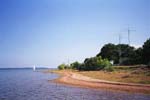
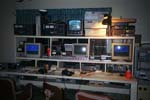
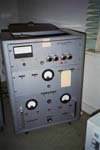
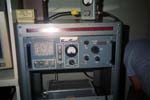
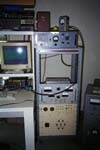
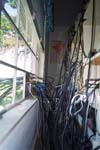
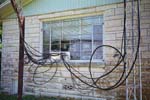
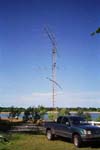
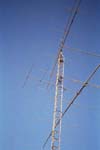
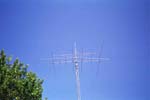
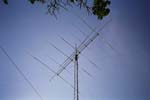
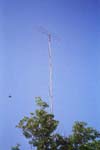
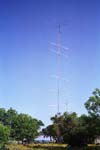
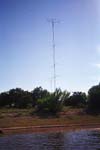
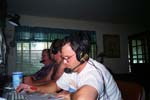
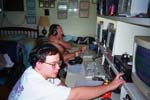
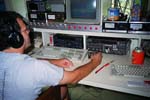
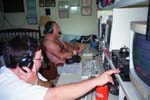
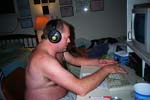
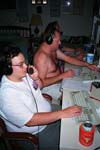
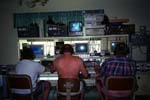
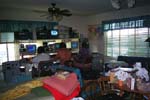
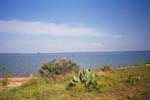

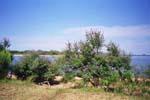
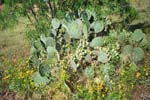
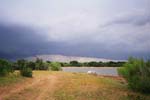
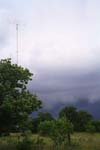
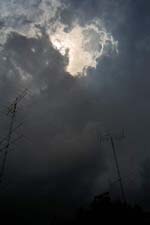
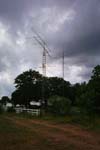
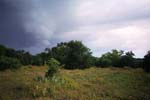
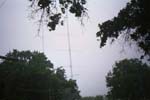
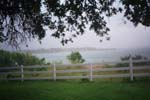
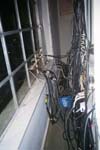
| ||||||||||||||||||||||||
|
I was invited to operate the 1999 ARRL June VHF QSO Party with the limited multi-operator team at the W5KFT Ranch Station. The family cattle ranch is located on the west shore of Lake Buchanan, in Llano County, TX, grid locator EM00st. This is near the northern edge of the Texas Hill Country, about 100 kilometers northwest of Austin, TX.
The team this year was Bryan W5KFT, George K5TR, Gator N5RZ, and Ken KM5FA. I was the new edition to the team this year, and it was my first opportunity to operate from a big Texas station in this contest. Conditions were apparently down from 1998, when W5KFT won the limited multi-operator category. According to K5TR, the Eskip openings on 50MHz were much weaker, and there was no significant enhanced propagation on 144MHz and up. This was the first year that the team used a transverter on 222MHz, and the first time they used more than 100W on 222MHz. 222MHz was the only band which produced better numbers in 1999 than in 1998.
I had a lot of fun.
These photos are copyright © 1999-2003 Kenneth E. Harker. All rights reserved.

|
The W5KFT Ranch Station is located on the western shore of Lake Buchanan, a reservoir of the Colorado River. Lake Buchanan is a level-controlled reservoir, so the ranch buildings can be built reasonably close to the water. In this photo, you can see the shorter tower with the six meter stack and 222MHz yagi, and the taller tower directly next to the station, with the 432MHz yagi, one of the 144MHz yagis, and an HF tribander. |

|
This is the operating table, photographed after the end of the contest. Just to the left of the table is the Henry 2006 amplifier for 50MHz. On the top shelf, left to right: Ameritron HF amplifier, 50MHz logging PC, Ameritron HF amplifier, television for local weather reports, the 222/432MHz logging PC, the 144MHz logging PC, and a spare, various brick amplifiers we didn't use and a converted FM commercial radio used for packet in HF contests. On the next shelf, from left to right: 50MHz wattmeter, unused rotor controller, HF bandpass filter, 50MHz logging monitor, 50MHz coax switch, clock, 50MHz high antenna rotor, unused rotor controller, DEMI 222-28 transverter, DEMI TIB, 50/222MHz rotor controller, 222/432MHz logging monitor, unused HF antenna patch panel, 144/432MHz rotor controller, high 144MHz rotor controller, 144MHz logging monitor. On the table, left to right: Icom IC-736 (50MHz), Kenwood TS-850 (unused), Kenwood TS-850 (222MHz), Yaesu FT-736R (432MHz), and Icom IC-275 (144MHz), plus three keyboards, two Heil Prosets, a pair of AKG headphones with a Heil mic boom and element, and three pair of Bencher iambic paddles. Below the table were DC power supplies, and to the right of the table was the homebrew 144MHz amplifier and the converted AM-6155 222MHz amplifier. |

|
This is the Arcos 432MHz amplifier. It is running a pair of 4CX250 tubes and output almost 500 watts that weekend. The cooling fan in this amplifier is not especially large, nor especially quiet. |

|
This is an AM-6155 amplifier retired from FAA service in ground-to-air AM transmissions. It has an 8930 tube. It was converted to use on 222MHz SSB/CW by George K5TR. It put out roughly 350 watts this weekend. It wasn't actually in the rack until Sunday afternoon, when a thunderstorm forced us off the air and gave us a few moments to move and adjust things. On top of the rack is a Bird 43 Thruline wattmeter. |

|
The bottom two-thirds of this rack is the homebrew 144MHz amplifier. Behind the mustard yellow panel is a high voltage power supply that was originally in service powering some sort of plasma generator. The RF deck above is a W6PO design, and is based on a single 8877 tube. The blue Diamond coax switch next to the Icom IC-275 let the 144MHz operator choose between antennas. This amplifier put out 1500 watts that weekend. Sitting on top of the rack is the AM-6155 222MHz amplifier. |

|
A view behind the operating table at all of the cabling involved in this station. As this station is used for a contest almost every other weekend, be it on VHF or HF, CW, SSB, or RTTY, much of this cabling must be re-wired for each weekend. |

|
Outside the station, this is the feedpoint entrance. All of the feedlines to the towers are elevated about eight to ten feet off the ground. This was done to make it easy to reconfigure things, and keep the feedlines high enough that the cattle don't chew on them. The tower next to the station supported the 432MHz yagi, and one of the 144MHz yagis. |

|
The shortest tower at the ranch: From bottom to top, 6-element 50MHz yagi at 18' fixed northeast. 5-element 50MHz yagi at 25' fixed northwest. 6-element 50MHz yagi at 38' on the rotor, and a 17-element 222MHz yagi at 40', also on the rotor. The 18' and 38' six meter yagis are fed with 7/8" hardline, and are hooked up to an Ameritron RCS-8V remote coax switch, and can be fed separately or together. The other antennas are fed with a mixture of 1/2" hardline and RG-213 coax. All of the antennas on rotors use RG-213 jumpers at their feedpoint for the rotor loop. |

|
Another view of this tower, from closer to the base. Here, the top and bottom six meter antennas are probably being used as a pair beaming to the northeast. This was our only antenna on 222MHz. |

|
This is the second shortest tower at the ranch. From bottom up, a HyGain TH77DX HF tribander antenna (which we did not use that weekend,) an M² 2M18XXX 18-element 144MHz yagi at 60', and a 31-element 432MHz yagi at 65', all on a single rotor. The 144MHz yagi on this tower was the "low" antenna on two meters. |

|
A view of the same tower, from closer to the base. This was our only antenna on 432MHz. The 432MHz yagi was fed with 1/2" hardline, and the 144MHz yagi was fed with 7/8" hardline. Both antennas used RG-213 for the rotor loops. |

|
This tower is the 15M/10M tower for the HF contests operated at the W5KFT Ranch Station. For the June VHF QSO Party, George K5TR installed a Cushcraft 17B2 17-element 144MHz yagi at 135', on the rotor. This was our "high" two meter antenna, and it was fed with 1/2" hardline. A previous owner had built this antenna with 10 of the 17 elements in the wrong positions. This is the second highest tower at W5KFT. There is a bird in this photograph as well. |

|
You can see both the high two meter tower and the 144/432MHz tower in this shot. The 50/222MHz tower is behind the trees, to the left of the taller tower. |

|
This is the 20M/40M tower for the HF contests operated at W5KFT. For the June VHF QSO Party, George K5TR installed an M² 7-element 50MHz yagi at 155', on the rotor, fed with a mixture of 1/2" hardline and RG-213. This is the tallest tower at W5KFT. |

|
On Saturday, from foreground to background: George K5TR on 50MHz, Gator N5RZ on 222/432MHz, and Bryan W5KFT on 144MHz. The headset that George is wearing is a pair of AKG heaphones with a Heil microphone boom and element. |

|
Ken KM5FA and Gator N5RZ, after a few hours into the contest. Gator is in the background, on 50MHz, and Ken is in the foregound on 144MHz, apparently adjusting a rotor. |

|
George K5TR making a CW contact on 432MHz with one of the many rovers, sometime on Sunday. All three logging computers were networked and running TR Log, which was also used as an electronic keyer to send CW. While everyone operated on each of the bands at some point during the contest, George operated mostly on 50MHz. |

|
Another view of Ken KM5FA in the foreground on 144MHz, and Gator N5RZ in the background on 50MHz. This was sometime on Sunday. Ken operated mostly on 144MHz. The logging computer for 144MHz was also equipped with a K1EA DVP digital voice processor card. |

|
Ralph "Gator" N5RZ, operating 50MHz. The logging computer for 50MHz was also equipped with a W9XT Contest Card digital voice keyer. Gator also operated a lot on the 222MHz and 432MHz bands, pulling out those weak signals and working many stations on CW. |

|
From foreground to background: Ken KM5FA on 144MHz, Gator N5RZ on 222/432MHz, and Bryan W5KFT on 50MHz. |

|
From left to right: George K5TR on 50MHz, Gator N5RZ on 222/432MHz, and Bryan W5KFT on 144MHz. Notice the television on the top shelf - it was used mainly for checking the weather patterns and semi-frequent storm warnings on Sunday. |

|
The station occupies the entirety of a guest house on the ranch. There are three twin-size beds and a couch available, as well as a small kitchen, refrigerator, dining table, bathroom, and porch. The station is, of course, air-conditioned. |

|
The view across Lake Buchanan from just outside the fence that runs in front of the ranch buildings. |

|
The shoreline on the other side of a small cove near the station. The land on the opposite shore is also a part of the cattle ranch. |

|
Most of the flowering bushes and wildflowers in central Texas have gone by mid-June, but this bush still has some small purple flowers on it. |

|
A small clump of cactus. This is the prickly-pear variety, and is quite common in the Texas Hill Country. There are a few small yellow wildflowers around it, but the cactus itself is no longer blooming. |

|
A severe thunderstorm rolled in on Sunday afternoon. We were off the air for about 45 minutes as a result, but nothing was damaged. |

|
Ominous clouds rolling in from the north toward the high six meter antenna tower. |

|
There was a lot of thunder. |

|
The station prepares to shut down. |

|
The wind has started to pick up a little. |

|
When it did start to rain, it really poured. The rain guage read over four centimeters of rain after the storm had rolled through. Here, the rain is so intense, you can barely see the towers from the porch of the station. |

|
The rain and wind is blowing around the bushes. |

|
After the end of the contest, when almost all of the cables had been disconnected. |
|
Last Updated 26 June 2020 wm5r@wm5r.org |